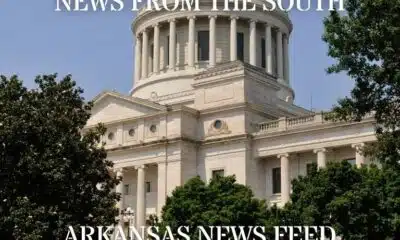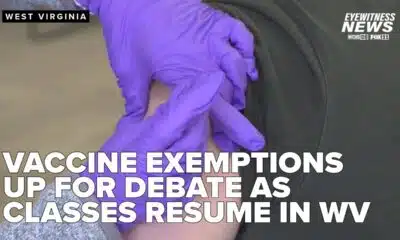News from the South - Texas News Feed
Texas river hit by flood has 13 summer camps in flood zone
“Along Guadalupe River, more than a dozen summer camps have structures in flood zones” was first published by The Texas Tribune, a nonprofit, nonpartisan media organization that informs Texans — and engages with them — about public policy, politics, government and statewide issues.
Sign up for The Brief, The Texas Tribune’s daily newsletter that keeps readers up to speed on the most essential Texas news.
The all-girls Christian summer camp where 27 people, most of them children, were swept away and killed by the July 4 flooding in Kerr County was just one of 13 summer camps along the Guadalupe River built on land prone to flooding.
The two Camp Mystic cabins where most of the flood victims were sleeping are in the Guadalupe River floodway, an area along waterways considered to be the most hazardous during a flood. Many of Mystic’s other buildings are located in the 100-year floodplain, considered to be less hazardous than a floodway but still prone to flooding during a severe storm.
Twelve other summer camps along the river in Kerr and Kendall counties are at least partially built on land within the 100-year floodplain, according to a Texas Tribune analysis of flood and property maps along the Guadalupe River.
“Unfortunately, I’m not surprised,” said Sarah Pralle, a Syracuse University associate professor who studies environmental policy. “We overbuild in flood zones everywhere across the country … but with camps it’s especially worrisome. You’re not just putting yourself at risk, you’re putting these children at risk who you’re supposed to be looking out for their safety.”
Five summer camps, including Mystic, have at least one-third of their camp structures located in the 100-year floodplain. That includes Heart O’ the Hills Camp in Hunt, where no campers were present but the camp’s longtime director was killed in the flooding.
Camp Capers in Waring, Camp Stewart for Boys in Hunt and Camp Waldemar in Hunt also have at least a third of their structures located in the 100-year floodplain.
The owner of Camp Waldemar, Meg Clark, testified before a legislative committee last week that all of its cabins are located on a bluff above the floodplain, allowing the camp to shelter in place until the river receded.
The Tribune analyzed Federal Emergency Management Agency maps used to determine flood risk for the National Flood Insurance Program. The maps help determine insurance rates for structures located within them and are often used by local governments to regulate new construction in the floodplain.
However, experts say the maps underestimate the risk posed. The modeling used to map 100-year floodplains, which have a 1% chance of flooding in any given year, is out of date because it is based on rainfall totals that have increased in recent decades as the climate warms and the warmer atmosphere can hold more moisture.
Satellite imagery reviewed by the Tribune shows the number of structures in the floodplain but doesn’t indicate the function of every structure.
The eight other summer camps with at least one-third of their structures located in the 100-year floodplain include:
- Presbyterian Mo-Ranch Assembly in Hunt
- Bear Creek Scout Camp in Hunt
- Camp La Junta in Hunt
- Camp Rio Vista for Boys in Ingram
- Camp Sierra Vista for Girls in Ingram
- Camp Honey Creek For Girls in Hunt
- Kickapoo Kamp for Girls in Kerrville
- Hermann Sons Life Camp-Riverside in Comfort
Camp La Junta evacuated all of its campers during the flooding and saw no injuries or deaths, according to a Facebook post.
Camps Rio Vista and Sierra Vista, which are owned and operated jointly, reported “significant” damage to the camps on social media.
A representative for Hermann Sons Life Camp-Riverside said the camp’s two buildings located in the floodplain were vacant but declined to comment further.
The 12 other camps with structures located within the floodplain did not respond to or declined requests to comment for this article.
Most camps are “grandfathered” out of current flood zone rules
How are so many summer camp structures located in the most flood-prone areas along the river?
Nearly all of the 13 camps are located outside of city limits. In Texas, county governments have no authority to implement zoning rules that could limit construction within the 100-year floodplain.
And many of these camps were built before the flood modeling was done and the risks were fully understood. This also allows them to be “grandfathered” out of any newer regulations for properties in the floodplain, and to obtain lower flood insurance rates. Only two of the 13 camps with property in the flood plain are not grandfathered.
Buildings that are significantly damaged by flooding typically lose that status once they are repaired or rebuilt.
Some guardrails exist when it comes to building on flood plains. For property owners in flood-prone areas to tap federal flood insurance, local governments have to enact minimum building standards set by the federal government. Property owners can also purchase private flood insurance, but it is typically more expensive.
Property owners can also contest FEMA floodplain designations to avoid the increased regulation and higher flood insurance rates that come with new construction in flood-prone areas. Camp Mystic, which opened in 1926 and has grandfathered status, successfully petitioned FEMA in 2013, 2019 and 2020 to remove some of its buildings from the 100-year flood map ahead of a camp expansion.
Many flood maps are out of date and don’t give a true picture of the flood risk, Pralle said.
Higher temperatures speed up evaporation from oceans and other bodies of water, and warmer air can hold more moisture, leading to more intense and frequent storms, according to the U.S. Geological Survey. Upward of 12 inches of rain fell in some areas of Hill Country on the morning of July 4.
And development replaces water-aborbing vegetation with impermeable surfaces like streets and rooftops that increase runoff into streams and rivers.
Flood maps are “not really showing you the accurate risk, so you would think camps would go the extra mile to be extra careful knowing the floodwaters could very likely go far beyond those lines,” Pralle said. “Risks don’t stop when they hit a line on a map, so the idea that it’s somehow less risky if you’re outside the flood zone is not true.”
Lawmaker weigh bills on disaster, evacuation plans for camps
Two special legislative committees appointed to come up with proposals in response to the July 4 weekend floods have mainly focused on disaster response rather than floodplain building regulations.
The House committee passed House Bill 19, which would require any property with cabins or designated spaces for camping to develop a “flood disaster plan.” The bill doesn’t stipulate what exactly the plan has to include, leaving that up to the Texas Division of Emergency Management.
Another bill would require all campgrounds in floodplains to have emergency evacuation plans that they would have to follow anytime the National Weather Service issued a flash flood warning. It would also require campground cabins to have ladders so people could climb onto rooftops as a last resort.
Texas Floodplain Management Association Executive Director Christopher Steubing said summer camps naturally want to be located near bodies of water, and the best way to prevent disaster in these areas is by educating property owners and visitors about flood risks. Better education on the risks would allow for better planning to make sure campers and camp staff can respond quickly in the event of a flood, Steubing said.
“If you’re going to be responsible for these lives that are coming in, and I think you see the Legislature starting to move in this direction, you’ve got to have certain things in place, and they’ve got to be practiced,” Steubing said.
“There was no warning”
Camp CAMP in Center Point, which serves children and adults with developmental, behavioral and physical disabilities, was built on a ridge 90 feet above the Guadalupe River, where campers swim, canoe and do other recreational activities, but the camp intentionally avoided building permanent structures along the riverbank, said Brandon Briery, the camp’s chief operating officer.
“With the most recent flood, there was no warning,” Briery said. “We wouldn’t have known to get things to higher ground, and would have just lost anything of any substance that was down there.”
The camp did lose a shed that stored river recreation equipment, along with several portable toilets for campers, Briery said. A pavilion constructed by local Eagle Scouts managed to survive the force of the water, Briery added.
Better warning systems and tighter government regulations are needed, Briery said, and camps need to understand the risks for their individual properties and act accordingly.
“I think that every organization, every property owner, has to make decisions for themselves,” Briery said. “Because of how we’re situated and how we utilize things, we mitigate a lot of risk. But I can’t really say for other camps what they should be doing. They have to make their decisions on their risk.”
Disclosure: Facebook as been a financial supporter of The Texas Tribune, a nonprofit, nonpartisan news organization that is funded in part by donations from members, foundations and corporate sponsors. Financial supporters play no role in the Tribune’s journalism. Find a complete list of them here.
More all-star speakers confirmed for The Texas Tribune Festival, Nov. 13–15! This year’s lineup just got even more exciting with the addition of State Rep. Caroline Fairly, R-Amarillo; former United States Attorney General Eric Holder; Abby Phillip, anchor of “CNN NewsNight”; Aaron Reitz, 2026 Republican candidate for Texas Attorney General; and State Rep. James Talarico, D-Austin. Get your tickets today!
TribFest 2025 is presented by JPMorganChase.
This article originally appeared in The Texas Tribune at https://www.texastribune.org/2025/08/13/texas-hill-country-summer-camps-kerrville-floodplain/.
The Texas Tribune is a member-supported, nonpartisan newsroom informing and engaging Texans on state politics and policy. Learn more at texastribune.org.
The post Texas river hit by flood has 13 summer camps in flood zone appeared first on feeds.texastribune.org
Note: The following A.I. based commentary is not part of the original article, reproduced above, but is offered in the hopes that it will promote greater media literacy and critical thinking, by making any potential bias more visible to the reader –Staff Editor.
Political Bias Rating: Center-Left
This article primarily focuses on environmental and public safety issues related to floodplain management and the risks faced by summer camps in flood-prone areas. It highlights concerns about outdated flood maps, climate change impacts, and regulatory gaps, which are topics often emphasized by center-left perspectives advocating for stronger environmental protections and government oversight. However, the article maintains a factual tone without overt partisan language or ideological framing, presenting expert opinions and legislative responses in a balanced manner. This results in a center-left leaning due to the emphasis on climate change and regulatory shortcomings, but with a generally moderate and informative approach.
News from the South - Texas News Feed
DEA agents uncover 'torture chamber,' buried drugs and bones at Kentucky home
SUMMARY: Federal agents in London, Kentucky, investigating Scottie Shelton, discovered a disturbing “torture chamber” in a metal building on his property, complete with restraints and weapons. They found a strong odor of decay and buried drugs, including 6,000 oxycodone pills and 1,200 grams of methamphetamine. Shelton admitted to burying drugs and unintentionally forgetting their locations. Authorities also uncovered numerous unreported animal remains, including deer skulls and bobcat mounts, leading to 24 state wildlife violation counts. Shelton faces federal charges for possessing methamphetamine with intent to distribute and is held in Laurel County Detention Center under U.S. Marshal custody.
The post DEA agents uncover 'torture chamber,' buried drugs and bones at Kentucky home appeared first on www.kxan.com
News from the South - Texas News Feed
Abrego Garcia released from prison, headed to family
SUMMARY: Kilmar Abrego Garcia, wrongfully deported and imprisoned, has been released from a Tennessee jail and is en route to Maryland to reunite with his family, his lawyer Sean Hecker confirmed. Abrego Garcia was deported in March due to an “administrative error” and faced federal human smuggling charges related to a 2022 Tennessee traffic stop. His attorneys argue the prosecution is vindictive and selective, citing violations of his due process rights. A 2019 immigration ruling bars his return to El Salvador, and ICE is restricted from immediate custody post-release. The case continues amid concerns over potential re-deportation.
The post Abrego Garcia released from prison, headed to family appeared first on www.kxan.com
News from the South - Texas News Feed
Texas Senate expected to take up GOP congressional map
“Texas Senate expected to take up GOP congressional map, last stop before Abbott’s desk” was first published by The Texas Tribune, a nonprofit, nonpartisan media organization that informs Texans — and engages with them — about public policy, politics, government and statewide issues.
Sign up for The Brief, The Texas Tribune’s daily newsletter that keeps readers up to speed on the most essential Texas news.
The Texas Senate on Friday was expected to consider a new congressional map gerrymandered to maximize Republican representation, putting the plan on a path to the governor’s desk after weeks of intense partisan clashing.
Republican lawmakers were poised to push the map through over fierce Democratic opposition, launching a national redistricting war from Albany to Sacramento while positioning the GOP to net up to five additional seats in Texas.
The map, demanded by President Donald Trump to fortify the GOP’s U.S. House majority in next year’s midterm election, would hand up to five additional U.S. House seats to Republicans by dismantling Democratic bastions around Austin, Dallas and Houston, and by making two Democrat-held seats in South Texas redder. The new lines would also keep all 25 seats already held by Republicans safely red.
The pickups are meant to help the GOP hold onto its razor-thin congressional majority in a midterm election year that is expected to favor Democrats — potentially making the difference between a continued Republican trifecta in Washington, or a divided government with one chamber intent on investigating Trump and bottlenecking his agenda.
That has put Texas lawmakers at the front lines of an issue with national stakes. Republicans earned kudos from Trump for pushing the new boundaries through the state House, while Democrats won support from national party figures, including former President Barack Obama, Democratic National Committee Chair Ken Martin and U.S. House Minority Leader Hakeem Jeffries of New York.
Though congressional lines are typically redrawn once every 10 years following the decennial census, Republicans justified the aggressive and unusual move to do so in the middle of the decade by saying it was legal to craft new boundaries at any point and for purely partisan gain. They also pointed to the party’s margins of victory in 2024 and the need to counter blue-state gerrymandering to further support their push.
The U.S. Supreme Court ruled in 2019 that states can draw electoral maps on partisan grounds. But under Section 2 of the Voting Rights Act, the lines cannot diminish people’s voting power based on race.
Democrats argued that the new map would increase Republicans’ advantage by unconstitutionally suppressing the vote of Black and Latino Texans. They framed the push as a power grab by Trump meant to stack the deck in next year’s election.
Texas’ anticipated approval of the map has set off a tit-for-tat redistricting push in California, where Gov. Gavin Newsom has proposed a map voters would have to approve that could yield five new Democratic-leaning seats, effectively offsetting GOP gains in Texas. Other blue-state governors and national Democratic leaders are backing retaliatory gerrymandering as the Trump administration also pushes GOP-controlled Florida, Indiana, Missouri and Ohio to draw more red seats.
The new Texas map cleared its biggest hurdle Wednesday when, after more than eight hours of tense debate, the state House adopted the plan along party lines.
Lacking the votes to stop the map in the GOP-dominated Texas Legislature, more than 50 House Democrats staged a two-week walkout earlier this month, grinding the lower chamber to a halt by denying the quorum needed to conduct business.
Republicans unleashed an unprecedented response to drag them back to Texas, issuing civil arrest warrants, asking a court to extradite them from Illinois, seeking to declare over a dozen Democrats’ seats vacant and clamoring for legislative punishments upon their return.
After most Democratic lawmakers returned to Austin Monday, Republican Speaker Dustin Burrows, seeking to maintain a quorum, required each of them to agree to a police escort to leave the Capitol building. Rep. Nicole Collier, D-Fort Worth, refused and was confined to the Capitol for the next 54 hours, prompting a national media frenzy.
Democrats portrayed the walkout as a victory for sparking a national movement in support of retaliatory redistricting, and as just the first part of a longer fight against the map. In the House on Wednesday, Democratic lawmakers pressed their Republican colleagues on the plan’s impact on voters of color, working to establish a record they could use in a legal challenge seeking to kill the lines before next year’s election.
“This fight is far from over,” Rep. Gene Wu of Houston, chair of the House Democratic Caucus, said after the map’s passage in the lower chamber. “Our best shot is in the courts. This part of the fight is over, but it is merely the first chapter.”
More all-star speakers confirmed for The Texas Tribune Festival, Nov. 13–15! This year’s lineup just got even more exciting with the addition of State Rep. Caroline Fairly, R-Amarillo; former United States Attorney General Eric Holder; Abby Phillip, anchor of “CNN NewsNight”; Aaron Reitz, 2026 Republican candidate for Texas Attorney General; and State Rep. James Talarico, D-Austin. Get your tickets today!
TribFest 2025 is presented by JPMorganChase.
This article originally appeared in The Texas Tribune at https://www.texastribune.org/2025/08/22/texas-congressional-redistricting-map-senate-governor-desk/.
The Texas Tribune is a member-supported, nonpartisan newsroom informing and engaging Texans on state politics and policy. Learn more at texastribune.org.
The post Texas Senate expected to take up GOP congressional map appeared first on feeds.texastribune.org
Note: The following A.I. based commentary is not part of the original article, reproduced above, but is offered in the hopes that it will promote greater media literacy and critical thinking, by making any potential bias more visible to the reader –Staff Editor.
Political Bias Rating: Center-Left
The article focuses on the Texas congressional redistricting map, highlighting its Republican origins and the partisan conflict it has sparked. It provides detailed coverage of Democratic opposition and criticisms, including concerns about voter suppression among minority groups, and frames Republican efforts as a “power grab” led by Trump. The inclusion of national Democratic figures’ support for opposition and the emphasis on Democratic strategies and responses suggest a slight lean toward a Center-Left perspective. However, the article maintains a measure of balance by covering Republican justifications and legal points, which keeps it from tilting strongly left or right.
-
News from the South - Florida News Feed6 days ago
Floridians lose tens of millions to romance scams
-
News from the South - Texas News Feed6 days ago
New Texas laws go into effect as school year starts
-
News from the South - Kentucky News Feed7 days ago
AmeriCorps is under siege. What happens in the communities it serves?
-
News from the South - West Virginia News Feed6 days ago
Religious exemption debate front and center amid new school year in WV
-
News from the South - Alabama News Feed6 days ago
Final steel girders placed on new Gulf Shores bridge, completion on track
-
News from the South - Arkansas News Feed6 days ago
Trump, Zelenskyy exit White House talks hopeful about security guarantee for Ukraine
-
News from the South - Alabama News Feed6 days ago
Despite federal shift, state health officials encourage COVID vaccines for pregnant women
-
News from the South - Tennessee News Feed7 days ago
Son hopes to get emergency visa following mother's death in East Tennessee














































